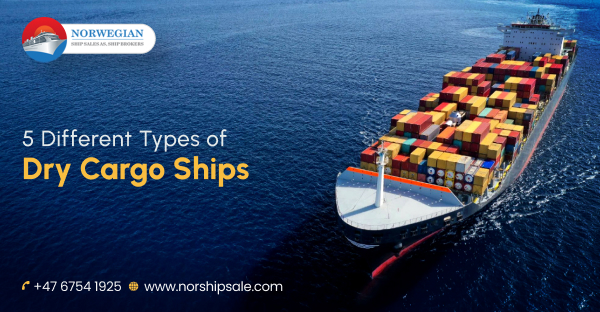Today, commercial vessels come in different types of shapes and sizes. They are built to carry a variety of cargo. Now, the cargo could be dry, in liquid form, or categorised as specialised cargo. Different types of vessels are designed to carry different types of cargo. For instance, dry cargo is carried by bulk carriers, container vessels, and more. In this blog, we have discussed the different types of vessels that are useful for carrying different types of dry cargo.
Before we start, you must remember that to enjoy the benefits that are provided by such ships, they ought to be well-built. So, if you live in Norway, and are thinking of buying top-notch dry cargo ships, then make sure you approach the best ship broker companies in Norway for the best suggestions and guidance.

5 Dry Cargo Ship Types
1. Bulk Carrier
The workhorses of the merchant fleet and bulk carriers transport the raw materials that, among other things, allow us to house, heat, and feed our populations as well as produce goods.
These ships can be recognised by the flat, long deck in front of the apartment, on which are located wide hatchways that allow access to the cargo compartments beneath the deck. The holds are protected from water ingress through the hatchways, which could harm the cargo or make the ship unsteady and result in cargo damage.
2. Ro-Ro Vessels
The term “Roll-on, Roll-off” and its acronym RoRo refers how a ship transports goods on wheels. In contrast to LO-LO (lift-on/lift-off) vessels, which utilise cranes to load and unload the cargo, RoRo ships include an internal ramp that enables the equipment to roll onto and off the vessel. RoRo ships are meant to transport cars, mining and road machinery, agricultural tractors, trucks, trailers, industrial vehicles, buses, and lorries.
The ramp is often located at the front or back of the ship, although occasionally on the sides or even on land. The ramp capacity on the majority of RoRo carriers is around 150 tonnes, however, on some vessels, it can reach 500 tonnes as well. Thanks to this method, it is considerably simpler and safer to load and unload wheeled items using these ramps than it would be to use a crane.
3. Container Vessels
A container vessel is a ship primarily built to transport large volumes of cargo that is packed into various containers (ships). Containerization is the technique of transporting shipments in unique containers. Container ships are one of the most effective means of moving cargo. These ships have effectively revolutionised global trade by making it possible to transfer large volumes of cargo at once.
Most seagoing non-bulk commodities are transported by container ships. In the modern era, container ships carry almost 90% of all non-bulk cargo. Container vessels are one of the primary means of transporting ready-to-use commodities around the globe. These containers are standardised in size to make it simple to move them between different modes of transportation.
4. General Cargo Vessels
General cargo ships are designed to transport all types of loosely packaged cargo, although they are not equipped to transport containers. A generic cargo ship could have one hold, many holds, and multiple decks.
One of the key characteristics of this kind of ship is that it has a series of onboard cranes that are used to load and unload goods when the ship is docked in port. Due to its versatility and capacity to carry a range of loads, it is also known as a multi-purpose vessel.
5. Reefer Vessels
A unique kind of cargo ship is the reefer ship. It is used to carry commodities that, as the name implies, must stay chilled the entire time while they are being transported or in situations where the cold chain cannot be broken. These commodities are typically meat or fish, although fruit can also be delivered on a refrigerated ship, including pineapples, bananas, and other tropical fruits.
Conclusion
Dry bulk ships typically travel at a constant pace of 14 knots, so a voyage from Brazil to China may take, on an average, 30 to 35 days. Ships used to travel at speeds of more than 20 knots, but this caused dangerous pollutants. As a result, ships now travel at lower speeds, consuming 40% less fuel.

